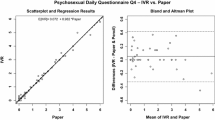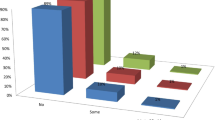Abstract
Purpose
The objective of this study was to evaluate the measurement equivalence of an interactive voice response system (IVRS) version and the original paper-based version of the EORTC QLQ-C30.
Methods
The QLQ-C30 is a cancer-specific, health-related quality of life questionnaire consisting of nine multi-item scales (physical, role, emotional, cognitive and social functioning, fatigue, nausea/vomiting, pain, and quality of life) and six single item measures (dyspnea, insomnia, appetite loss, constipation, diarrhea, and financial problems). This study utilized a crossover design with subjects randomly assigned to one of two assessment orders: (1) paper then IVRS or (2) IVRS then paper. Equivalence between the two administration modes was established by comparing the 95 % lower confidence interval (CI) of the intraclass correlation coefficients (ICCs) for each scale, with a critical value of 0.70.
Results
The ICCs for the nine multi-item scales were all above 0.79, ranging from 0.791 to 0.899 (ICC 95 % lower CI range 0.726–0.865) and significantly different from our threshold reliability of 0.70. The ICCs for the six single items ranged from 0.689 to 0.896 (ICC 95 % lower CI range 0.611–0.888). Two of the items, insomnia and appetite loss, were not statistically different from 0.70. When considered together, the per-protocol analysis results support the equivalence of the paper and IVRS versions of the QLQ-C30 for 13 of the 15 scores.
Conclusion
This analysis provides evidence that the scores obtained from the IVRS version of the QLQ-C30 are equivalent to those obtained with the original paper version except for the insomnia and appetite loss items.

Similar content being viewed by others
References
US Food and Drug Administration (2009). Guidance for industry: Patient-reported outcome measures: Use in medical product development to support labeling claims. Available at: http://www.fda.gov/downloads/Drugs/GuidanceComplianceRegulatoryInformation/Guidances/UCM193282.pdf.
Lipscomb, J., Reeve, B. B., Clauser, S. B., et al. (2007). Patient-reported outcome assessment in cancer trials: Taking stock, moving forward. Journal of Clinical Oncology, 25, 5133–5140.
Osoba, D., Aaronson, N. K., Zee, B., et al. (1997). Modification of the EORTC QLQ-C30 (version 2.0) based on content validity and reliability testing in large samples of patients with cancer. Quality of Life Research, 6, 103–108.
Bottomley, A., & Aaronson, N. K. (2007). International perspective on health-related quality of life research in cancer clinical trials: The European Organization for Research and Treatment of Cancer experience. Journal of Clinical Oncology, 25, 5082–5086.
National Cancer Institute (2002). A manual for participants in clinical trials of investigational agents sponsored by DCTD, NCI. Available at: http://ctep.cancer.gov/investigatorResources/docs/hndbk.pdf. Accessed September 5, 2011.
Bloom, D. E. (1998). Technology, experimentation, and the quality of survey data. Science, 280, 847–848.
Taenzer, P. A., Speca, M., Atkinson, M. J., et al. (1997). Computerized quality-of-life screening in an oncology clinic. Cancer Practice, 5, 168–175.
Tourangeau, R., & Smith, T. W. (1996). Asking sensitive questions: The impact of data collection mode, question format, and question context. Public Opinion Quarterly, 60, 275–304.
Velikova, G., Wright, E. P., Smith, A. B., et al. (1999). Automated collection of quality-of-life data: A comparison of paper and computer touch-screen questionnaires. Journal of Clinical Oncology, 17, 998–1007.
Bushnell, D. M., Reilly, M. C., et al. (2006). Validation of electronic data capture of the irritable bowel syndrome—Quality of life measure, the work productivity and activity impairment questionnaire for irritable bowel syndrome and the EuroQol. Value Health, 9, 98–105.
Stone, A. A., Shiffman, S., Schwartz, J. E., et al. (2002). Patient noncompliance with paper diaries. BMJ, 324, 1193–1194.
Coons, S. J., Gwaltney, C. J., Hays, R. D., et al. (2009). Recommendations on evidence needed to support measurement equivalence between electronic and paper-based patient-reported outcome (PRO) measures: ISPOR ePRO good research practices task force report. Value Health, 12(4), 419–429.
Crow, J. T. (1986). Receptive vocabulary acquisition for reading comprehension. Modern Languages Journal, 70, 242–250.
Henriksen, B. (1999). Three dimensions of vocabulary development. Studies in Second Language Acquisition, 21, 303–317.
Abu-Hasaballah, K., James, A., & Aseltine, R. H, Jr. (2007). Lessons and pitfalls of interactive voice response in medical research. Contemporary Clinical Trials, 28, 593–602.
Corkrey, R., & Parkinson, L. (2002). Interactive voice response: review of studies 1989–2000. Behavior Research Methods, Instruments and Computers, 34(3), 342–353.
Alemi, F., Stephens, R., Parran, T., et al. (1994). Automated monitoring of outcomes: Application to the treatment of drug abuse. Medical Decision Making, 14, 180–187.
Agel, J., Greist, J. H., Rockwood, T., et al. (2001). Comparison of interactive voice response and written self-administered patient surveys for clinical research. Orthopedics, 24, 1155–1157.
Juniper, E. F., Scatz, M., Juniper, B. A., & Zeiger, R. (2008). Evaluation of 2 interactive voice-response telephone versions of health-related quality-of-life questionnaires. Journal of Allergy and Clinical Immunology, 122, 654–655.
Lauritsen, K., Degl’ Innocenti, A., Hendel, L., Praest, J., Lytje, M. F., Clemmensen-Rotne, K., et al. (2004). Symptom recording in a randomized clinical trial: Paper diaries vs. electronic or telephone data capture. Controlled Clinical Trials, 25, 585–597.
Weiler, K., Christ, A. M., Woodworth, G. G., Weiler, R. L., & Weiler, J. M. (2004). Quality of patient-reported outcome data captured using paper and interactive voice response diaries in an allergic rhinitis study: Is electronic data capture really better? Annals of Allergy, Asthma & Immunology, 92, 335–339.
Wilson, S. J., Rich, A. S., Rich, N. C., Potokar, J., & Nutt, D. J. (2004). Evaluation of actigraphy and automated telephoned questionnaires to assess hypnotic effects in insomnia. International Clinical Psychopharmacology, 19, 77–84.
Aaronson, N. K., Ahmedzai, S., Bergman, B., Bullinger, M., Cull, A., Duez, N. J., et al. (1993). A quality-of-life instrument for use in international clinical trials in oncology. Journal of the National Cancer Institute, 85, 365–376.
Bjordal, K., de Graeff, A., Fayers, P. M., Hammerlind, E., et al. (2000). A 12 country field study of the EORTC QLQ-C30 (version 3.0) and the head and neck cancer specific module (EORTC QLQ-H&N35) in head and neck patients. European Journal of Cancer, 36, 1796–1807.
Gundy, C.M., Aaronson, N.K. (2010). Effects of mode of administration (MOA) on the measurement properties of the EORTC QLQ-C30: A randomized study. Health and Quality of Life Outcomes 8:35. Available at: http://www.hqlo.com/content/8/1/35.
Lundy, J. J., & Coons, S. J. (2011). Measurement equivalence of interactive voice response and paper versions of the EQ-5D in a cancer patient sample. Value Health, 14, 867–871.
Hills, M., & Armitage, P. (1979). The two period cross-over clinical trial. British Journal of Clinical Pharmacology, 8, 7–20.
Shrout, P. E., & Fleiss, J. L. (1979). Intraclass correlations: Uses in assessing rater reliability. Psychological Bulletin, 86, 420–428.
McGraw, K.O., Wong, S.P. (1996). Forming inferences about some intraclass correlation coefficients. Psychological Methods, 1(1), 30–46 (Correction: Vol. 1, No. 4, 390).
Streiner, D. L., & Norman, G. R. (2003). Health measurement scales: A practical guide to their development and use (3rd ed.). New York: Oxford University Press.
Acknowledgments
The data used for this research were collected as part of a study funded by ClinPhone Plc (now Perceptive Informatics). Additional support was provided by the University of Arizona Cancer Center Support Grant CA023074 from the National Cancer Institute. The authors gratefully acknowledge the staff and facility support provided by the University of Arizona College of Pharmacy and the University of Arizona Cancer Center’s Behavioral Measurements Shared Service. JJL and SJC were employed by the University of Arizona at the time this study was conducted. The authors have no financial interest in Perceptive Informatics or ClinPhone PLC.
Author information
Authors and Affiliations
Corresponding author
Rights and permissions
About this article
Cite this article
Lundy, J.J., Coons, S.J. & Aaronson, N.K. Testing the measurement equivalence of paper and interactive voice response system versions of the EORTC QLQ-C30. Qual Life Res 23, 229–237 (2014). https://doi.org/10.1007/s11136-013-0454-1
Accepted:
Published:
Issue Date:
DOI: https://doi.org/10.1007/s11136-013-0454-1




